Interesting Football Stories– IV
I Don't Need to Be There
Knute Rockne became coach at his alma mater, Notre Dame, in 1918.
- During his 13-year tenure – which ended abruptly in a plane crash – he won 105 games while losing only 12, with 5 ties.
- ND had five perfect seasons.
The Irish might have had another in 1926 except for what one writer has called "one of the greatest coaching blunders in history."
- On November 26, Notre Dame traveled to Pittsburgh to play Carnegie Tech.
However, Rockne did not accompany the team.
- Instead, he attended the Army-Navy game in Chicago.
- Although the cover story was that he was scouting Army for the following season, it was later revealed that he along with Stanford's Pop Warner and Yale's Tad Jones were paid to write newspaper articles about the service academy clash and select an All-American team.
- Rockne wrote Christy Walsh, one of the first sports agents and the man who put the three-coach deal together:
The game in Pittsburgh will not be important enough ... I can (put) it in charge of someone else.
- Knute even considered taking his starters with him to Chicago to rest them for the big game with USC. However, he backed off when news of
his plan became public.
His decision to let assistant Hunk Anderson coach the game didn't seem so rash at the time.
- ND had beaten Carnegie four
years in a row by a combined score of 111-19.
- Tech did little recruiting, had fewer than 30 players, and only a part-time coach, Judge Walter Steffen.
- Furthermore, Rockne's team had given up only 7 points (to Minnesota) in the first eight games.
Insulted by Rockne's disdain, Tech played far above its abilities.
- Anderson started the second team. He would later be assailed for this, but he was actually following the usual procedure of his boss who often sent in the starters after the opponent had been softened up.
- The Tartans led 13-0 at halftime on their way to a shocking 19-0 victory. A goal-line stand in the fourth quarter preserved the shutout.
- Some newspapers refused to print the score when the wire service sent it across the country, waiting for the correction. Others called for confirmation before including it.
- The game is always included in any list of top upsets in college football history.
Rockne accompanied his team to Los Angeles the next week, where they defeated USC 13-12 to end the
season. The lone defeat undoubtedly cost the Irish the national championship.
Carnegie Tech upgraded its football program in the next few years to the point that the school won the Lambert Trophy as best team in the East in 1938.
|

Knute Rockne
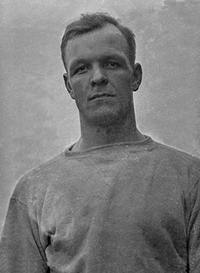
Hunk Anderson |
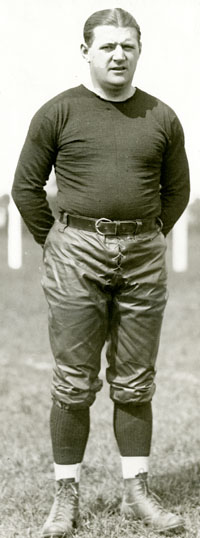 Eagles coach Bert Bell |
Worst Passing Team in NFL History
The 1936 Philadelphia Eagles were coached by Bert
Bell, a co-owner of the team. Those Eagles
had undoubtedly the worst passing attack in NFL history.
- Eight different players combined to complete just 22.9% (39 for 170). Dave
Smukler completed 21 of 68, by far the most completions of any player on the team.
- They threw 35 interceptions and only three touchdowns!
- The cellar-dwelling Eagles scored only 51 points in a 1-11 season.
- They defeated the Giants
10-7 in their opening game. In the second meeting with New
York, they scored 17 points, their most in any game that season.
Despite compiling a 10-46 record as Eagles coach from 1936-40, Bell went on to become NFL Commissioner (1946-1959). In that role, he negotiated the league's first national TV contract and laid the foundation for his successor,
Pete Rozelle, to build the world's most popular sports league.
|
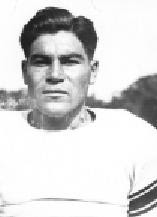
Dave Smukler |
|
66 Years to Get His Letter
One of the Memorable Football Games features on this Web site discusses the December 6, 1941, clash between Williamette
(OR) and Hawai'i.
The game is memorable because of what happened the next day – the Japanese attack on Pearl Harbor.
The Hawai'i QB was Mun Kin (M.K.) Wong. He didn't exactly fit today's profile of a college signal-caller. He was only 5' 8" and 145 pounds.
The victory over Williamette ran the Rainbows record to 8-1. Hawai'i began the season on the mainland with victories at Pacific and Portland. Then they played three other island teams (the Hawaii Bears,
Na Alii, and Healani) twice each.
The loss came in the first game against Healani.
The Rainbows were scheduled to meet San Jose State in the "Shrine Bowl," which was actually a series of three
games matching all combinations of Hawai'i, Williamette,
and San Jose State. However,
only the first game was played.
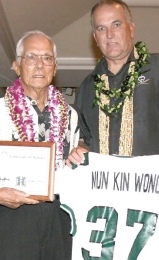 |
Wong, like most of his teammates, enlisted in the Hawaii Territorial Guard. He served five years in the Guard. Hawai'i football did not resume until 1946. By that time, he had married his high school sweetheart and went to work in his father's drapery business
(where he still works today at age 85). However, he had one regret about his football career. "I really wanted a varsity letter," he says. "That's why I went out for football in the first place. I
remember saying to myself, I don't care if I have to sit on the bench for four years; I'm going to get that letter."
Wong finally got his letter in August, 2007, at a banquet hosted by then
Hawai'i coach June Jones. After showing a video of the 1941 team, Jones presented Wong,
the only surviving member of the team, with his letter. Wong
then gave a pep talk to the current Hawai'i team which was in attendance. Afterwards, the current star QB, Colt Brennan, shook Wong's hand. "The guy has lived an incredible life," said Brennan.
"He made all of us think about where we live and what we stand for."
Obviously Wong's pep talk worked as the Warriors (as the Rainbows are not called) completed an undefeated season that earned them an invitation to the Sugar Bowl. And Brennan became one of the four finalists
for the Heisman Trophy. |
Reference: "Special Delivery of a Letter," Rick Reilly,
Sports Illustrated |

Earl Blaik |
56 Points per Game
The only coach whose team averaged 56 points in a game in one season was Earl "Red" Blaik of Army in 1944. That squad featured "Mr. Inside" Doc Blanchard and "Mr. Outside" Glenn Davis, both of whom later won the Heisman Trophy ( Blanchard in 1945, Davis in 1946).
Greatly helped by the fact that college programs were decimated by the military service of so many young men during World War II, the Cadets outscored opponents 504-35 during their 9-0 season. The victories included a 46-0 rout of North Carolina, 69-7 over Pittsburgh, 59-0 over Notre Dame,
and 23-7 over Navy.
Personal note: Blanchard's Heisman Trophy is the only
one I have ever held in my hands. This came about because Doc
donated his trophy to his high school alma mater, St.
Stanislaus College in Bay St. Louis MS. The Heisman
was rescued after Katrina and brought to Baton Rouge where it was kept
in the residence where I lived after the storm. It is now back in its
rightful place on the Mississippi Gulf Coast.
Reference: Touchdown: Great Moments and Dubious Achievements in Football History, John S. Snyder |
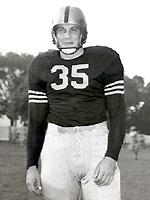
Felix "Doc" Blanchard
|
|
Fired at Halftime
Rex Keeling's debut as a punter for the Cincinnati Bengals on December 1, 1968, was so pitiful that Hall of Fame coach Paul Brown cut him at halftime.
The Bengals' regular punter had just been called to military duty. So Brown called Keeling, who had tried out for the Bengals before the season. Selling cars for his father in Alabama, Keeling jumped at the chance. Although he hadn't punted in months, he boomed 50 yarders during practice. However, against the Boston
Patriots he averaged only 28.3 yards on six punts and had one partially blocked. Late in the second quarter, Brown had so little confidence in Keeling that he called a fake punt at midfield. However, Rex bobbled the snap, tried to run with the ball, and finally threw it forward underhanded. It hit the ground but was ruled a fumble. Boston took possession and soon scored to lead 26-0 at the half.
Brown blasted Rex at halftime. "This game is just too
big for you! You just can't handle it! You're gone!" Brown then turned to his son Mike, a team executive. "Write this boy out a check for what we owe him." Then, loud enough for all to hear, Brown muttered, "That's what I get for trying to make a kicker out of a used-car salesman."
Reference: The Football Hall of Shame, Bruce Nash and
Allan Zullo |
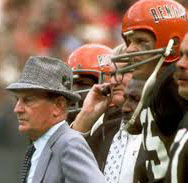
Paul Brown |
|
Nixon's Play
The Washington Redskins started the 1971 season 6-1. Then they went into a slump, losing two and tying one. To give the team a lift, Coach George Allen reached out to none other than the President of the United States, Richard Nixon.
- Allen had first met Senator Richard Nixon in 1951 after Allen had completed a championship season (9-1) as head coach at Whitter College (CA), where Nixon had been a member of the football team. Their friendship continued when Allen coached the Los Angeles Rams in the mid-1960s.
- Nixon traveled to the Redskins' practice facility by helicopter and impressed the players with his knowledge of their backgrounds as well as statistics and formations.
- In gratitude, Allen turned his team over to the Chief Executive and allowed the visitor to call one play. Nixon chose a reverse, and it was successful.
- The Redskins won the next three games before losing the finale to finish 9-4-1. The result was their first post-season berth in 25 years.
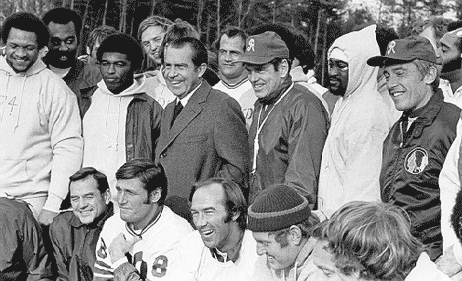
President Richard Nixon at Redskins Park with Coach George Allen at his left.
Marv Levy is at the far right, two people to Allen's left.
The Redskins traveled to Candlestick Park to face the San Francisco 49ers the day after Christmas.
- The underdog Redskins led 10-3 late in the first half. They had the ball on the 49ers 8y line with a chance to make it a "two-possession game" (to use a phrase not applied to football until decades later).
- Let George Allen's daughter Jennifer explain what happened next.
|
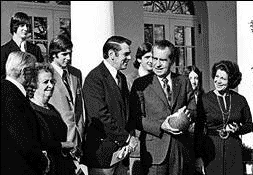
Coach George Allen with President Richard Nixon after winning the NFC Championship in 1973; 11-year-old Jennifer Allen is behind Nixon's left shoulder. |
My father called a play he had never before called, and would never call again – a reverse to the wide receiver – something he once referred to as a "trick play" and a "gimmicky play." The 49ers defense read the play at the snap of the ball and turned it into a 13-yard loss. Noting its gross failure, one TV broadcaster quipped, "That must have been a play Richard Nixon called in to George Allen."
The subsequent field goal was blocked, and the game's momentum quickly shifted. Washington went on to lose 24-20. In the postgame locker room, one player claimed that my father had received "executive orders" to call the play. My father neither denied nor upheld the truth of this claim. He simply spoke of the reverse as "the game's big, big play ... when we came away without any points."
The following day, Washington reporters blamed Nixon for the team's defeat. And several days later, columnist Art Buchwald noted, "If George Allen doesn't accept any more plays from Richard Nixon, he may go down in history as one of pro football's greatest coaches."
Knowing her father tried to control every detail of his football team's functioning, Jennifer doubts that George would have run a play just because the president suggested it.
Marv Levy, future coach of the Buffalo Bills' Super Bowl teams who was the Washington special teams coach under Allen, later said that George had fed the play to Nixon and told the president to call him so it would seem like Allen was taking the play from the president.
|
Frank Howard and Bear Bryant
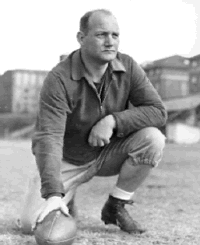
Frank Howard
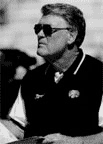
Hayden Fry |
This story was told by Frank Howard, longtime coach at Clemson.
A bunch of us from around the country got invited every year to a coaches golf outing. One year the event was in Arkansas where a river ran right alongside the golf course. The organizers, knowing I didn't play golf, arranged for me to go fishing down by the river. Now that I liked.
On my way to meet the fishing guide, I ran into Coach [Hayden] Fry [SMU]. He said it sounded like fun and came along. When we got to the river, we found we were going to drift the river in a canoe, not a boat.
After we got under way, the guide told Coach Fry to pick a lure out of the tackle box and tie it on the end of his line. I guess Hayden figured, "the bigger the better!" He picked out a big ol' spinner lure and cast it out with all his might. You'll never believe this, but the thing sailed a mile high, went up in a tree alongside the bank, and hooked a squirrel! The squirrel tumbled out of the tree, splashed into the river, and Coach Fry stood up in the canoe to reel him in. Between him standing and me dying of laughter, the canoe tipped over. We're lucky we didn't all drown.
Soaking wet, we managed to make it to the river bank. When we climbed up, we found ourselves on the edge of one of the fairways of the golf course. And who is coming down in the next foursome but the Bear. "Frank, what in the world happened to you?" Coach Bryant asked. "Well, Bear, I'll tell you," I answered. "Everybody's always told me that you could walk on water, so I thought I'd try it myself."
Reference: Wallace Wade: Championship Years at Alabama and Duke,
Lewis Bowling |
|
Ice Bowl Aftermath
The 1967 NFL Championship Game is remembered for the inhumane conditions in which it was played.
- -13º temperature at kickoff.
- Winds up to 30 mph, creating a -48º wind chill factor.
- A layer of ice covering most of the field.
- Frozen whistles as well as frozen wheels on the TV cameras.
Green Bay won 21-17 on Bart Starr's QB sneak in the last minute.
This story concerns an incident that occurred later that day. As often happens as the years pass, the details vary according to who's relating the tale.
- CBS chartered a four-seater to fly its broadcasting crew to Chicago after the game.
- Frank Gifford sat next to the pilot. Jack Buck and Tom Brookshier sat in the seats behind them.
- As the plane reached an altitude of 500', the door next to Gifford came open. Since he hadn't secured his safety belt, he was being pulled out of the plane.
- Brookshier, a former DB, grabbed Gifford by the neck of his jacket to keep him from falling out of the plane. Frank managed to stay onboard but broke the arm rest. As a result, the door could not be completely closed, and he had to hold it to keep it from flying open.
- According to another account, the door flew off the plane. In either case, as Buck later recalled, "If you thought it was cold on the football field at Green Bay, you should have been up about 2,000'."
- The pilot found the nearest airstrip in Wisconsin and managed to land safely. When the group finally reached the Windy City, Buck says, "I celebrated New Year's Eve with the hottest bath I've ever had in my life."
References: Somewhat conflicting stories of the flight are told in Book of Football Stuff by Ron Martirano and The Golden Voices of Football by Ted Patterson and Keith Jackson
|
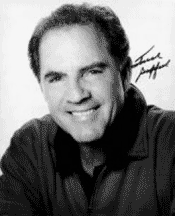
Frank Gifford
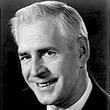
Jack Buck
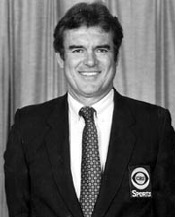
Tom Brookshire |
Jackson Covered for Woody?
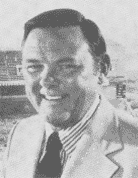
Keith Jackson
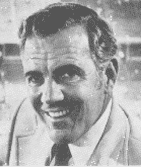
Ara Parseghian
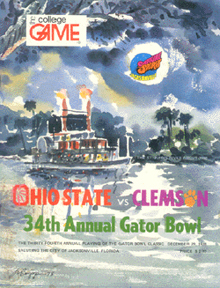

Hayes Pummels Bauman
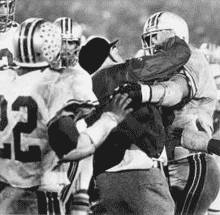
Hayes grabs face mask of OSU player trying to restrain him. |
We'll tell two Woody Hayes stories. The first is a prelude to the second.
During his tenure at Ohio State (1951-1978), Woody didn't like the media and, unlike most coaches, made no attempt to court them.
- As ABC prepared to televise the Purdue-Ohio State game in 1967, Woody reluctantly loaned a copy of his playbook to announcer Chris Schenkel. It had become common practice among coaches to do so. Chris liked to familiarize himself with the contestants' offenses in order to better describe the game for the audience.
- The night before the game, Woody knocked on Schenkel's hotel door and demanded his playbook back. "I don't trust you," he told Chris. What made Hayes' mistrust all the more ludicrous was that his offense was known for being old-fashioned and unsophisticated. There were hardly any secrets in the playbook that opponents couldn't decipher just by watching the Buckeyes on film.
- ABC announcer Keith Jackson said, "Woody Hayes was a very difficult man for television people to work with. There was absolutely no relationship between Woody and me. None. The man wouldn't cooperate, wouldn't let you get close to him."
Fast forward to December 29, 1978. Jackson and former Notre Dame coach Ara Parseghian announced the Gator Bowl between Ohio State and Clemson.
- ABC made what turned out to be a widely-criticized decision to cut costs for the telecast. It saved about $5,000 by not purchasing a "net return" feed for the game. The fateful effect of the move was that the director was limited in the replays he could show. Also, ABC had no sideline reporter at the game.
- In the last minutes of the game, Ohio State was driving for at least a FG to overcome Clemson's 17-15 lead. However, Charley Bauman intercepted a pass near the Buckeyes' sideline to clinch the game. As Bauman ran out of bounds, Hayes grabbed him and gave him a forearm to the neck and continued pummeling him until he was restrained by players from both teams.
- Neither Jackson nor Parseghian saw the sideline incident and were puzzled as to what caused the melee. The director showed a replay of the interception from the end zone camera, but the footage ended just as Bauman went out of bounds. So Jackson expressed again his ignorance as to what had set off the altercation.
- When order was restored, Ohio State was penalized 15 yd for unsportsmanlike conduct. Then, two plays later, Hayes was assessed another penalty for coming onto the field to argue with the officials. The penalties had no effect on the game because Clemson simply ran out the clock to preserve its two-point victory.
The executive vice president of ABC Sports, Jim Spence, saw the incident in his hotel room in New Orleans where he was preparing for the upcoming Sugar Bowl.
- Spence phoned the ABC truck at the Gator Bowl and told producer Bob Goodrich to order Jackson to say something about Hayes' action.
- Keith refused, saying that he hadn't seen what had set off the brawl. And, of course, there was no sideline reporter to explain what had transpired.
Watch the ABC video of the Gator Bowl incident.
There was no ESPN yet, but Woody's actions were seen by millions on the evening news on tv stations across the country.
- In the days to come, some journalists accused Jackson of covering up for Hayes, not knowing that Jackson disliked Woody.
- Writers also raised the question of whether TV networks could objectively cover the games considering they were, in effect, in bed with both the bowls and the colleges. Criticize a famous coach and risk losing your TV contract with the NCAA or the Gator Bowl.
- Jackson saw the replay of the incident for the first time the next morning on the local NBC affiliate in Jacksonville, which had taped it off the air. "The whole thing still pisses me off," Jackson has said. "Too many people ducked and ran for cover."
- "People thought we were purposely ignoring the whole thing to protect Woody," Parseghian said later. "We had no reason to do that."Bauman diagrees.
Hayes had gotten away with tearing up down markers and other such temper tantrums that were seen only by the spectators at the stadium. But this incident occured on national tv. Ohio State had no choice but to demand his resignation, which he delivered before leaving Jacksonville.
Reference: The 50 Year Seduction: How Television Manipulated College Football, from the Birth of the Modern NCAA to the Creation of the BCS, Keith Dunnavant |
Football Goes Better with Coke
|
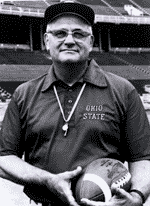
Woody Hayes
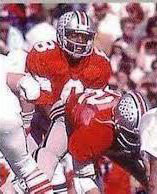
Rod Gerald

Bill Walsh

Art Schlister
|
Rod Gerald had no enthusiasm for the Orange Bowl game his Ohio State Buckeyes would play against Colorado after the 1976 season.
- Gerald, a sophomore, had started the season as the replacement behind C for Cornelius Greene, who had graduated as one of OSU's greatest QBs ever. But in the seventh game, against Purdue, Rod fractured three vertebrae, which sidelined him for the rest of the regular season.
- Jim Pacenta had started the rest of the way. Even though Gerald was cleared to play in Miami, he knew Coach Woody Hayes would start Pacenta.
On January 1, 1977, the day of the game, an incident occurred that changed Rod's life.
- A former OSU teammate offered Gerald some cocaine. Like many of his teammates, Rod had smoked marijuana, but he had never tried cocaine. Depressed about his prospects of playing that evening, he figured, "Why not?" So he tried some.
- When Colorado jumped out 10-0, Hayes sent Gerald in for Pacenta. Rod gained 17y on his first carry, then led the Buckeyes on a 99y TD drive to spark the 27-10 victory. The night culminated with the backup QB being voted the Orange Bowl MVP.

Rod Gerald scores for Ohio State in the 1977 Orange Bowl Gerald regained the starting job for the 1977 season.
- Hayes reluctantly let Stanford's new head coach, Bill Walsh, come to OSU's spring practice to tutor Gerald on the fundamentals of passing.
- Still, the QB and the entire O struggled in the season opener, defeating Miami (FL) 10-0. Hayes announced afterwards, "We've got to get more juice in our attack."
- Gerald decided to try cocaine again the morning of the next game. The result was a 38-7 Buckeye romp. Rod felt faster and more elusive, like he had never injured his back.
- As a result, Rod continued to snort cocaine before each game. His habit nearly got the best of him before the SMU game. When he went to the pregame QBs meeting, he noticed his nose was bleeding. "That's it. I'm gone," he thought. But the team physician merely gave Gerald a towel to wipe his nose. Neither the doctor nor Hayes connected the nosebleed with cocaine use. As the season progressed, Gerald didn't limit his coke use to game days. He also experimented with other drugs.
- For the annual season-ending game at Michigan, Rod decided he needed extra help. After snorting Saturday morning, he put some cocaine inside his wristband to keep him high throughout the game. He would sniff some on the sidelines and even in the huddle. It made him feel invincible. That was why he caused two fumbles in the first half. On both plays, as Gerald ran the option, the D collapsed the play. But instead of taking a loss, he foolishly tossed the ball to a teammate. Then, late in the game, with OSU trailing 14-6, Rod made another bad lateral deep in enemy territory to end OSU's last hope.
When the team traveled to New Orleans to face Alabama in the Sugar Bowl, Gerald had a problem.
- He didn't have any cocaine and didn't know where to get it. As a result, the QB had a poor day in the 35-6 Tide rout.
- By that point, rumors were rampant that Gerald was using drugs. But, with Hayes increasingly out of touch with his players, nothing was done as the new season started. Anyway, Woody had turned the O over to freshman phenom Art Schlichter for 1978.
- Back on the bench, Gerald spent most days using cocaine, speed, barbiturates, and other amphetamines.
- After playing sparingly, he left school without a degree. Eventually, he went into rehab and finally graduated.
Schlichter, had a stellar career at Ohio State but, ironically, fell victim to a gambling addiction in the NFL.
Reference: War As They Knew It: Woody Hayes, Bo Schembechler, and America in a Time of Unrest, Michael Rosenberg |
|
CONTENTS
I Don't Need to Be There
Worst Passing Team in NFL History
66 Years to Get His Letter
56 Points per Game
Fired at Halftime
Nixon's Play
Frank Howard and Bear Bryant
Ice Bowl Aftermath
Jackson Covered for Woody?
Football Goes Better with Coke
Football Stories – I
Football
Stories – II
Football Stories – III
Football Stories – V
Football
Stories – VI
Football Stories – VII
Football Stories – VIII
Football Stories - IX
Football Stories - X
Football
Magazine
Golden Rankings Home
Top of Page |






















